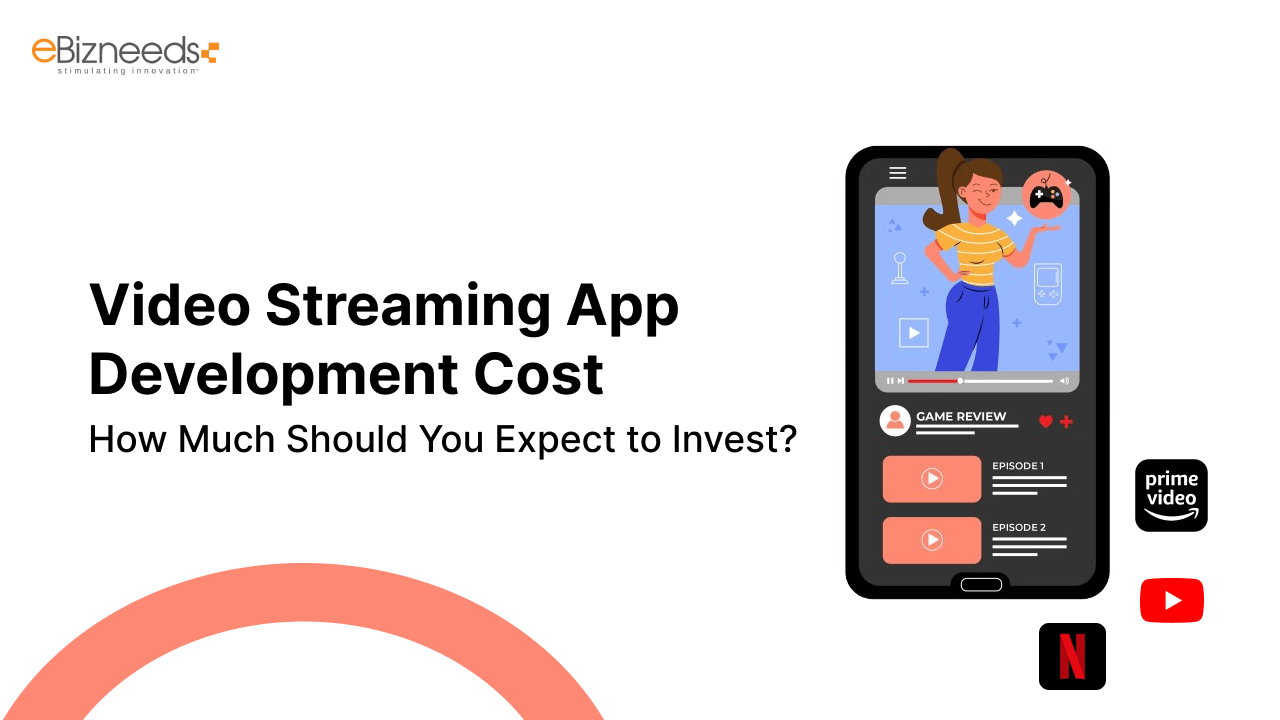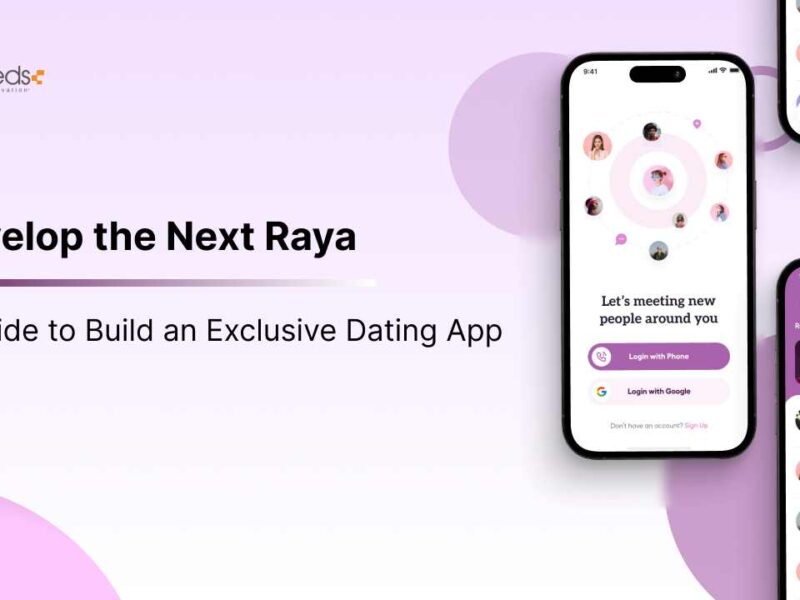Thinking about launching a video streaming app?
With the boom in demand for video content, it’s an exciting time to enter the market. But one question is on every entrepreneur’s mind: What will it cost to develop a video streaming app?
Let’s get right to it.
On average, developing a video streaming app can range between $30,000 and $200,000. Surprised?
This cost variation comes from factors like the features you want, the complexity of the user experience, and the technology stack behind it.
For example, a simple app with basic video playback will naturally cost less than an advanced platform with live streaming, multi-language support, and robust security measures.
Why is this cost worth considering?
Today’s audience wants flexibility. They want to binge-watch, share, and interact, which means they’re actively looking for high-quality streaming options.
By investing in a top-notch streaming app, you’re meeting users where they already are.
Plus, the market is primed for growth. The global streaming industry is estimated to reach over $330 billion by 2030.
It’s a no-brainer that this is a massive opportunity, and with the right investment in development, your app could be positioned to capture a slice of this lucrative pie.
So, if you’re contemplating whether to build a streaming app or wondering if it’s worth the investment, here’s the answer:
The demand is high, the market is growing, and the cost—while substantial—reflects the value of a well-built product.
Enough said, let’s get right into it:
Should You Build a Video Streaming App?
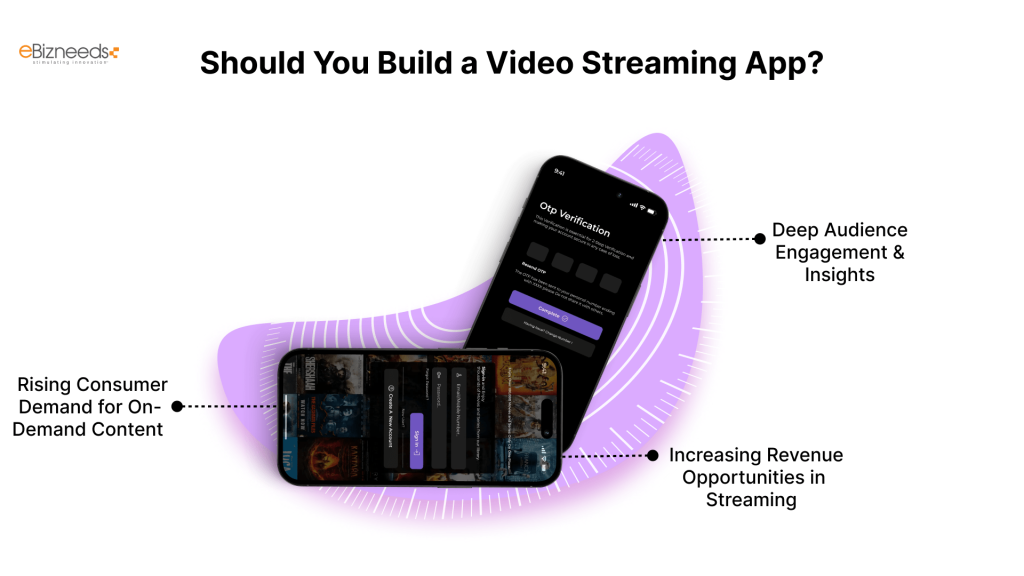


You might be wondering, Is building a video streaming app worth it?
Let’s explore why, for many businesses, the answer is a resounding “yes.”
Video streaming isn’t just a trend; it’s a transformative way to engage and expand your audience.
Here are three compelling reasons why developing a video streaming app can be a smart move.
1. Rising Consumer Demand for On-Demand Content
Today’s audience wants content at their fingertips, and they want it instantly.
According to a recent survey by Statista, over 80% of internet traffic is now video content, and the demand for on-demand video streaming is only growing.
Users are switching from traditional TV to apps, and they’re willing to pay for high-quality content.
So, if you have valuable content to offer, there’s an audience ready to consume it.
2. Increasing Revenue Opportunities in Streaming
The video streaming industry is on an upward trajectory, estimated to surpass $330 billion globally by 2030.
Video streaming platforms generate revenue through subscriptions, ads, pay-per-view, and more, giving you multiple ways to monetize.
Whether you’re planning a Netflix-style subscription model or a free app with ads, video streaming offers flexibility and high returns.
3. Deep Audience Engagement & Insights
Unlike traditional broadcasting, streaming apps allow you to track user behavior, content preferences, and engagement metrics in real time.
With these insights, you can tailor your content and marketing strategies, keeping users engaged for longer.
In fact, HubSpot reports that 70% of marketers believe video provides better engagement than other formats.
In short, building a video streaming app lets you meet your audience’s demands, tap into a profitable industry, and create a deeper connection with users. If you’re looking to expand your brand’s reach and generate sustainable revenue, a streaming app could be the game-changer you’ve been waiting for.
Average Cost to Develop a Video Streaming App
So, how much does it really cost to develop a video streaming app?
While every app is unique, there are some general figures you can expect to work with based on the complexity and features you need.
At a basic level, if you’re looking for a simple video streaming app with essential features like user accounts, video playback, and a search function, the development cost typically starts around $30,000 to $50,000.



This type of app suits smaller audiences or niche content providers.
For a more advanced app, such as one supporting live streaming, multi-device compatibility, and advanced security features, you can expect costs to range between $80,000 and $150,000.
This category often includes mid-level video streaming apps with a focus on audience engagement and personalization.
On the high end, building a full-scale video streaming platform with premium features like AI-based recommendations, multilingual support, offline downloads, and high-level encryption can bring costs up to $200,000 or more.
This tier is best suited for large enterprises looking to compete with big players like Netflix or Hulu.
In addition to these base costs, remember that video streaming app development also includes ongoing maintenance expenses, typically around 15-20% of the initial development cost annually.
Maintenance is crucial for updates, bug fixes, and security upgrades to keep your app running smoothly and securely.
Ultimately, the cost of developing a video streaming app reflects your app’s goals, complexity, and required features. By understanding these general price ranges, you can better plan your budget and decide on the features that align with your vision.
Factors That Affect Video Streaming App Development Cost
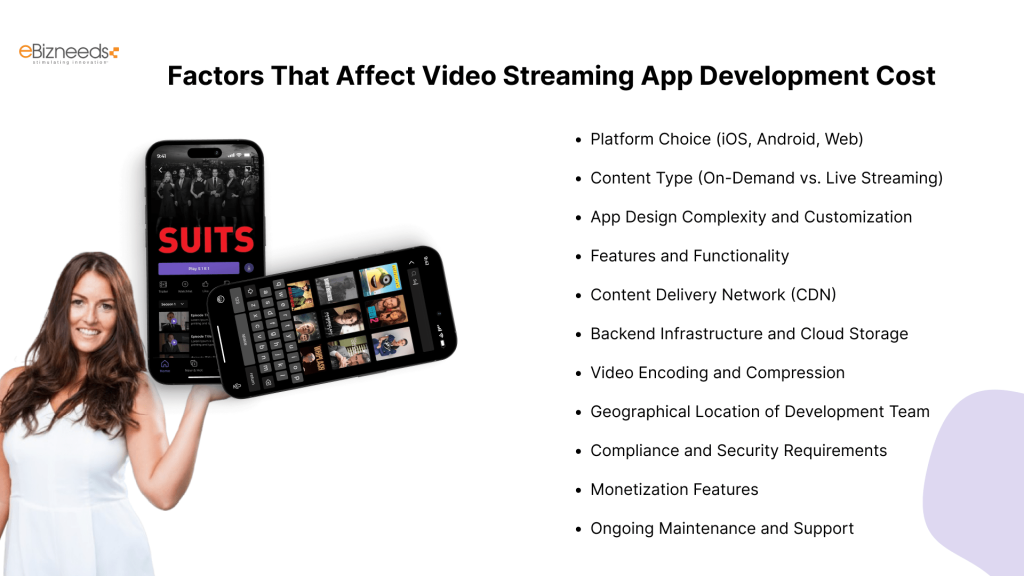


Developing a video streaming app involves several variables, each contributing to the overall cost.
Here are key factors, along with cost figures for each, to help you estimate your budget effectively.
1. Platform Choice (iOS, Android, Web)
Choosing between iOS, Android, or a web app impacts costs significantly. A single-platform app typically starts around $30,000 to $50,000. Opting for cross-platform development or adding a web app can increase costs by 30-40%, potentially raising the budget to $60,000 to $80,000 for a multi-platform solution.
| Platform | Estimated Cost | Platform |
| Single Platform (iOS or Android) | $30,000 – $50,000 | Single Platform (iOS or Android) |
| Cross-Platform (iOS + Android + Web) | $60,000 – $80,000 | Cross-Platform (iOS + Android + Web) |
2. Content Type (On-Demand vs. Live Streaming)
On-demand content is more affordable, while live streaming requires real-time data processing and higher server capabilities. Adding live streaming can increase costs by $10,000 to $20,000, depending on the required infrastructure, making the overall budget $40,000 to $70,000 for an app with both on-demand and live content.
| Content Type | Estimated Cost |
| On-Demand Only | $30,000 – $50,000 |
| With Live Streaming | $40,000 – $70,000 |
3. App Design Complexity and Customization
A basic design generally costs $5,000 to $10,000, while advanced, customized designs with animations and unique user interfaces can raise design costs to $15,000 to $25,000. Investing in UI/UX can improve user engagement but will add 15-25% to total development costs.
| Design Complexity | Estimated Cost |
| Basic Design | $5,000 – $10,000 |
| Advanced Custom Design | $15,000 – $25,000 |
4. Features and Functionality
Basic features like video playback and search functions are essential, costing around $10,000 to $15,000. Adding advanced features like AI recommendations, multilingual support, and offline downloads can push the cost up by an additional $20,000 to $50,000, with the final budget falling between $40,000 and $100,000 depending on the feature set.
| Feature Type | Estimated Cost |
| Basic Features | $10,000 – $15,000 |
| Advanced Features | $20,000 – $50,000 |
5. Content Delivery Network (CDN)
A CDN is crucial for seamless content delivery. Implementing a CDN like AWS CloudFront or Akamai can cost $5,000 to $15,000 depending on usage. This can account for about 10-15% of your total budget and is vital for high-quality streaming without buffering.
| CDN Service | Estimated Cost |
| Basic CDN Integration | $5,000 – $15,000 |
6. Backend Infrastructure and Cloud Storage
A reliable backend infrastructure and cloud storage are essential for video quality and content scalability. Setting up a robust backend and cloud storage can cost $15,000 to $30,000, often around 25-30% of your total budget, especially when dealing with high-quality video content and numerous concurrent users.
| Backend Infrastructure | Estimated Cost |
| Cloud Storage & Backend | $15,000 – $30,000 |
7. Video Encoding and Compression
Adaptive bitrate streaming (ABS), which optimizes video quality based on the viewer’s internet speed, enhances user experience but increases costs by $3,000 to $7,000. Encoding and compression are critical for quality and can add 5-10% to your development costs.
| Video Compression | Estimated Cost |
| Encoding & ABS Integration | $3,000 – $7,000 |
8. Geographical Location of Development Team
Developer rates vary by location. In the U.S., developer costs can be $100 to $150 per hour, bringing total development expenses to around $120,000 to $200,000. Eastern Europe or Asia offers cost-effective alternatives at $20 to $50 per hour, reducing the total to $30,000 to $80,000 depending on app complexity.
| Location | Estimated Hourly Rate |
| U.S./Western Europe | $100 – $150 |
| Eastern Europe/Asia | $20 – $50 |
9. Compliance and Security Requirements
Security features, including encrypted logins, payment gateways, and GDPR compliance, add $5,000 to $10,000 to your development costs. This typically makes up 10-15% of the total budget, ensuring data protection and legal compliance, especially when handling sensitive user information.
| Security Features | Estimated Cost |
| Compliance & Security | $5,000 – $10,000 |
10. Monetization Features
Adding monetization options like subscriptions, pay-per-view, and ads can increase costs by $5,000 to $15,000. Each method involves unique integrations, and monetization features typically add 5-10% to the project cost but enable long-term revenue generation.
| Monetization Type | Estimated Cost |
| Subscriptions/Ads/Pay-per-View | $5,000 – $15,000 |
11. Ongoing Maintenance and Support
Maintenance costs are typically 15-20% of the initial development cost per year, covering bug fixes, updates, and server management. This translates to around $5,000 to $10,000 annually for a basic app, or $15,000 to $30,000 for a more complex solution.
| Maintenance Aspect | Estimated Cost (Annual) |
| Bug Fixes and Updates | 15-20% of initial cost |
| Simple App | $5,000 – $10,000 |
With these factors in mind, the total cost of developing a video streaming app can vary widely based on your choices in design, functionality, and backend requirements. This breakdown should help you prioritize features based on your budget and goals.
Popular Video Streaming Apps & Cost to Clone Them
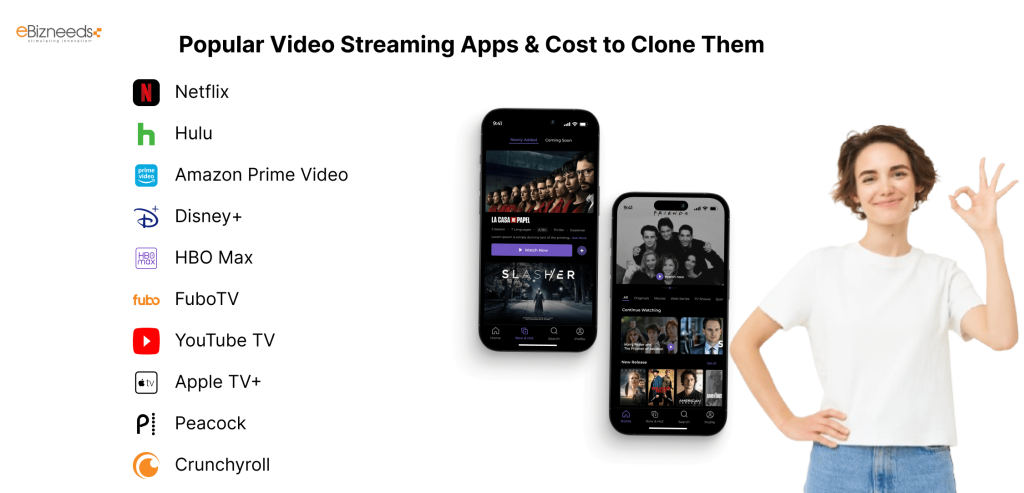


If you’re considering developing a video streaming app, it helps to look at the most popular ones in the market. Each of these apps offers unique features that appeal to specific audiences, and cloning their core functionality comes with varying costs. Here’s a look at 10 popular video streaming apps and the estimated cost to build similar versions.
1. Netflix
As the global leader in on-demand streaming, Netflix offers personalized recommendations, multi-language support, and offline downloads. Cost to develop an Netflix would range from $150,000 to $250,000.
2. Hulu
Known for both on-demand content and live TV, Hulu combines diverse content offerings with flexible subscription models. Building a Hulu clone would typically range from $120,000 to $200,000, depending on the complexity of live TV integration.
3. Amazon Prime Video
Amazon Prime Video’s extensive library, premium movies, and regional content make it a powerful platform. To develop a similar app with multi-device support and original content features, expect costs between $130,000 and $220,000.
4. Disney+
Disney+ targets a family-friendly audience with exclusive Disney, Pixar, and Marvel content. Creating a Disney+-like app with robust security and custom branding features can cost around $120,000 to $200,000.
5. HBO Max
HBO Max offers premium content, including HBO originals, movies, and TV shows. Building an app with similar quality and catalog features is estimated to cost between $130,000 and $210,000.
6. YouTube TV
YouTube TV combines live streaming with on-demand videos, offering DVR capabilities. Developing a YouTube TV-like platform would require additional backend features, bringing the cost to around $100,000 to $180,000.
7. FuboTV
FuboTV is popular for live sports streaming with HD quality and DVR features. Cloning FuboTV’s key functionalities for sports and live streaming can cost from $150,000 to $220,000.
8. Apple TV+
Apple TV+ focuses on high-quality original series and movies. An app clone with similar features and premium content handling would cost approximately $120,000 to $200,000.
9. Peacock
Peacock offers a blend of free and premium content with ads. Building a Peacock-like app with freemium and ad-based models is estimated at $100,000 to $170,000.
10. Crunchyroll
Crunchyroll caters to anime fans, with a subscription model for premium access. Developing an app like Crunchyroll, which includes extensive content libraries and multi-language support, can cost $80,000 to $150,000.
Each of these cost estimates covers cloning the app’s core features but does not include unique customization or additional high-end features that may raise development costs. When deciding on the right app model, consider your target audience and specific content focus to choose the features most relevant to your business goals.
How to Minimize Video Streaming App Development Cost
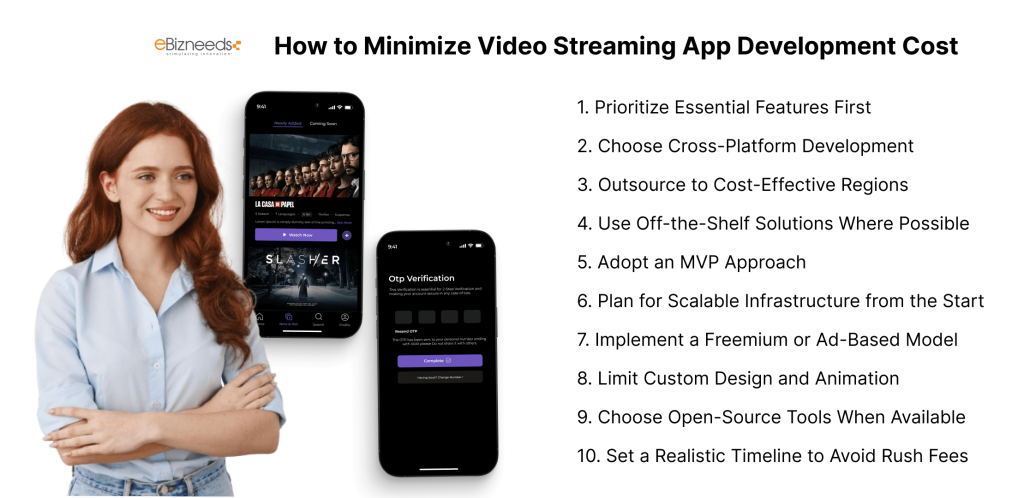


Building a high-quality video streaming app doesn’t have to break the bank. By adopting cost-saving strategies, you can create a powerful app while staying within budget. Here are some effective ways to keep development costs manageable.
1. Prioritize Essential Features First
It’s tempting to add every possible feature, but focusing on core functionalities will help control initial costs. Begin with essential features like video playback, user profiles, and search functions. You can always add advanced features like recommendations or multi-language support later, after you see how users interact with your app.
2. Choose Cross-Platform Development
If you want to reach both iOS and Android users without doubling development costs, consider cross-platform frameworks like Flutter or React Native. Cross-platform development can reduce costs by 30-40% since you only need one codebase for both platforms. It’s a cost-effective way to expand your reach while saving on resources.
3. Outsource to Cost-Effective Regions
Hiring developers from regions with lower rates, such as Eastern Europe or Asia, can significantly reduce expenses without compromising quality. Development costs in these regions are generally 40-60% lower than in North America. Look for reputable development teams with a strong track record in video streaming to ensure quality while cutting down on costs.
4. Use Off-the-Shelf Solutions Where Possible
For features like user authentication, payment gateways, or CDN integration, using pre-built solutions can save time and money. Platforms like Firebase for authentication, Stripe for payments, and AWS CloudFront for CDN services can be integrated easily and cost less than building these from scratch.
5. Adopt an MVP Approach
Building a Minimum Viable Product (MVP) allows you to launch a basic version of your app quickly, gathering user feedback to guide future updates. By focusing on essential features first, you can minimize initial costs and use real user insights to decide on the next features to develop. This approach also reduces the risk of investing in features users may not value.
6. Plan for Scalable Infrastructure from the Start
Although it may seem counterintuitive, planning for scalability early on can save you money in the long run. By choosing a scalable backend solution, like AWS or Google Cloud, you avoid the high costs of restructuring your app’s backend when your user base grows. Scalable infrastructure lets you expand seamlessly as demand increases.
7. Implement a Freemium or Ad-Based Model
If you want to generate revenue early, consider a freemium model or ad-supported approach. This helps offset costs and provides you with funds to reinvest in app development. Ad-based models are particularly popular for free streaming apps, enabling you to earn from ads while keeping the app accessible to a broad audience.
8. Limit Custom Design and Animation
Highly customized UI/UX designs, animations, and transitions are visually appealing but can quickly increase costs. Instead, opt for a clean, user-friendly design that focuses on functionality. Avoid overloading the app with animations at the start; you can always introduce customizations in later updates.
9. Choose Open-Source Tools When Available
Open-source libraries and tools can cut down both time and costs. For example, open-source frameworks like FFmpeg for video processing and VLC for media streaming can be integrated without license fees, providing reliable solutions for video playback at no extra cost.
10. Set a Realistic Timeline to Avoid Rush Fees
Last-minute changes and rushed deadlines often increase costs due to overtime charges or expedited work. Planning a realistic timeline allows your development team to work efficiently and focus on quality, avoiding unnecessary costs associated with expedited work.
By implementing these strategies, you can develop a robust video streaming app without overspending. Planning carefully, prioritizing essential features, and leveraging cost-effective resources can help you build an app that meets user expectations and fits within your budget.
Your Partner in Video Streaming App Development
Looking to bring your video streaming app vision to life? eBizneeds is here to help. With expertise in developing top-tier streaming apps, we understand the complexities involved in creating a seamless and scalable video streaming experience. From feature-rich on-demand platforms to live streaming apps, our team tailors solutions to match your business needs and budget.
As a trusted OTT app development company, eBizneeds ensures that every step—from initial consultation to post-launch support—is handled by experienced professionals dedicated to your success. We focus on creating apps that engage users, drive revenue, and provide exceptional streaming quality, regardless of audience size.
Ready to build an app that captivates your audience and stands out in the market? Let eBizneeds be your partner in delivering a high-performance video streaming app. Reach out to discuss your project and get a personalized development plan.
Conclusion
Building a video streaming app is an exciting and rewarding venture, especially with today’s rising demand for digital content. While the development cost depends on several factors, a well-planned approach can make the process efficient and cost-effective.
By understanding the investment involved and prioritizing essential features, you can create an app that stands out in a competitive market and meets your audience’s needs. Partnering with an experienced team, like eBizneeds, ensures your project stays on track, within budget, and aligned with industry standards.
FAQs
Developing a basic video streaming app with essential features like video playback, search, and user profiles typically costs between $30,000 and $50,000. The final cost can vary based on design complexity and platform choice (iOS, Android, or both).
Core features include user accounts, video playback, search, content management, and payment integration. Advanced features like live streaming, offline downloads, and AI-driven recommendations enhance the app’s appeal and user engagement.
Development timelines vary, but a basic app usually takes 3-6 months to complete. More complex apps, especially those with advanced features and multi-platform support, may take 6-12 months or longer.
Absolutely. Many businesses launch with a Minimum Viable Product (MVP) and add features based on user feedback. Working with an experienced development team ensures your app is scalable, making future feature additions easier.
Popular monetization options include subscriptions, pay-per-view, ad-based models, and freemium setups. Choosing the right model depends on your target audience and content strategy. Many apps also use a combination of these methods to maximize revenue.



Naveen Khanna is the CEO of eBizneeds, a company renowned for its bespoke web and mobile app development. By delivering high-end modern solutions all over the globe, Naveen takes pleasure in sharing his rich experiences and views on emerging technological trends. He has worked in many domains, from education, entertainment, banking, manufacturing, healthcare, and real estate, sharing rich experience in delivering innovative solutions.
